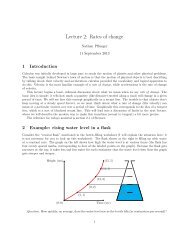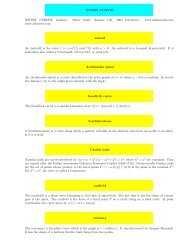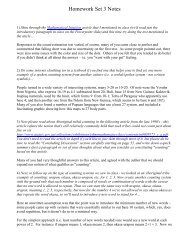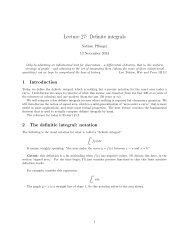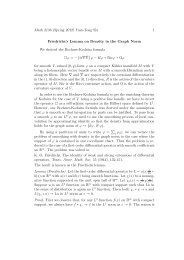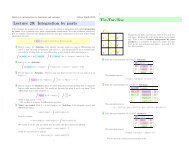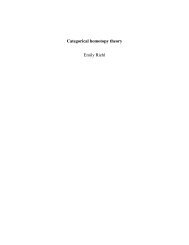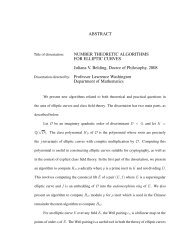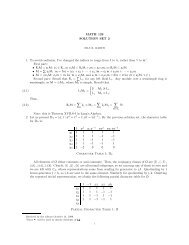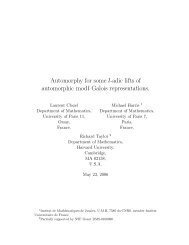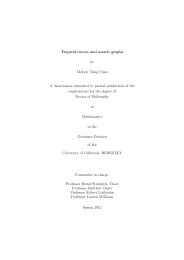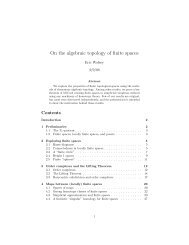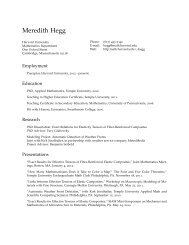Gauge theory for embedded surfaces, II
Gauge theory for embedded surfaces, II
Gauge theory for embedded surfaces, II
Create successful ePaper yourself
Turn your PDF publications into a flip-book with our unique Google optimized e-Paper software.
<strong>Gauge</strong> <strong>theory</strong> <strong>for</strong> <strong>embedded</strong> <strong>surfaces</strong>, <strong>II</strong> 19<br />
If γ is zero we shall say that the convergence is strong on the neck, and if in<br />
addition there are no points of concentration xi we say that the convergence is<br />
strong. Otherwise, we describe the situation above by saying that the sequence<br />
[Am ′] is converging weakly to the pair (A, B).<br />
Proposition 3.17. If the sequence [Am] converges weakly to the pair (A, B),<br />
and if the convergence is strong on the neck, then r1(A) =r2(B),whereri are<br />
the maps to the representation variety R(Y )=R( ¯ Y). ⊓⊔<br />
For the gluing theorem, we turn the situation around. Suppose that A and B<br />
belong to Mκ1(X o 1 ; R) andMκ2(X o 2;R) respectively, and that r1(A)=r2(A)=ρ<br />
in R⊂R(Y). For simplicity later, suppose that ρ belongs to the smooth part<br />
R s of one of the two irreducible components, R+ or R−.<br />
For large R, we can make a small modification to the connection A so that<br />
it is equivalent to the flat connection ρ on the end Y × [ R, ∞) of the manifold<br />
X o 1 . Making a similar modification to B allows us to join the two connections to<br />
<strong>for</strong>m a connection A#B on (X,gR) which deviates from anti-self-duality only in<br />
the neck region. (Since ρ is irreducible, there is no effective ‘gluing parameter’<br />
here.) This construction can be made in a family, in the following sense: if U1<br />
and U2 are small neighbourhoods of A and B in their respective moduli spaces,<br />
and if U1 ×r U2 denotes the fibre product<br />
U1 ×r U2 = { (u1,u2)|r1(u1)=r2(u2)},<br />
then we can <strong>for</strong>m a map<br />
˜ΦR : U1 ×r U2 −→ Bk(X ) (3.18)<br />
to the space of connections of topological action k on X, withk=κ(A)+κ(B).<br />
The main gluing result comes in two parts [MM].<br />
Proposition 3.19. Suppose that A and B are regular points of their respective<br />
moduli spaces, and suppose that the maps r1, r2 are transverse at (A, B). Then<br />
we can find neighbourhoods Ui as above such that <strong>for</strong> all R sufficiently large, the<br />
map ˜ ΦR can be de<strong>for</strong>med to a map<br />
ΦR : U1 ×r U2 −→ Mk (X,gR)<br />
which is a diffeomorphism onto its image. Furthermore, all points in the image<br />
of ΦR are then regular points of the moduli space Mk(X,gR). ⊓⊔<br />
Proposition 3.20. Let Am ∈ Mk(X,gRm) be a sequence converging strongly to<br />
apair(A, B) on X o 1 ∪X o 2 . Suppose that A, B are regular points of their respective<br />
moduli spaces and that r1, r2 are transverse at (A, B). Then <strong>for</strong> all sufficiently<br />
large m, the connection Am is in the image of the gluing map ΦRm. ⊓⊔<br />
Contained in Proposition 3.19 is the statement that the <strong>for</strong>mal dimensions<br />
of the moduli spaces compose according to the rule<br />
dim Mk(X) = dim Mκ1(X o 1 ; Rs ) + dim Mκ2(X o 2 ; Rs ) − (6g − 6) (3.21)



